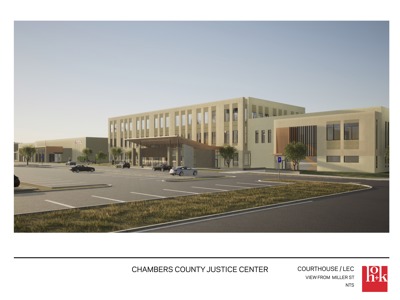
Chambers County Jail and Justice Center
Americus Holdings
The Chambers County Jail and Justice Center (CCJC) is a definitive example of how Public-Private Partnerships (P3s) can be used to simultaneously meet urgent public safety needs, drive regional revitalization, and preserve historic legacy. Delivered through an innovative Design-Build-Finance-Maintain (DBFM) model, the CCJC is not only a justice facility, but a comprehensive civic hub situated in the heart of downtown Anahuac, Texas. With a 336-bed jail, new courtrooms, a sheriff’s office, crime lab, expanded law enforcement and evidence facilities, and a replacement public library, the project exemplifies multi-agency coordination, stakeholder engagement, and delivery excellence. Innovation in Procurement, Structure, Finance, and Delivery The CCJC project was procured under a two-phase P3 approach beginning with a Pre-Development Services Agreement (PDA). This strategy allowed the County to collaborate with the developer—Americus Holdings—and its team of architects, contractors, and financial professionals to co-develop plans, refine costs, and mitigate risk before issuing debt or commencing construction. The PDA model empowered Chambers County to avoid issuing general obligation bonds and instead pursue an alternative financing structure. Under the final structure, approximately $165 million in Lease Revenue Bonds were issued by the Chambers County Local Government Corporation (CCLGC). The project site was leased to a special purpose entity (SPE), which borrowed the bond proceeds and leased the completed facility back to the County. This lease-purchase model retained public ownership, preserved balance sheet flexibility, and earned an “AA” bond rating from S&P—uncommon for rural county infrastructure. This structure further enabled speed to delivery. Unlike traditional municipal procurement processes—which are often prolonged by elections, funding gaps, or procedural delays—the P3 structure ensured continuity, transparency, and cost certainty from planning through construction. Effective Risk Assessment and Transfer A hallmark of this project was the deliberate and effective allocation of risk. The Guaranteed Maximum Price (GMP), locked in before design completion and construction start, insulated the County from cost escalation during a time of unprecedented inflation. Despite multi-month delays related to historical preservation mitigation and regulatory agency reviews, the GMP was held firm—a testament to the partnership’s integrity and financial structure. Design, construction, and performance risk was shifted to the private sector. The County retained only programmatic and operational control. Financial risks related to debt issuance, interest rate fluctuation, and capital markets were borne by the CCLGC and the developer’s financial partners. This framework ensured that cost, schedule, and performance liabilities rested with those best equipped to manage them. Meeting and Exceeding Project Milestones Despite complex stakeholder engagement and regulatory hurdles, the CCJC advanced on an aggressive timeline. Financial close was achieved within 12 months of executing the PDA. Construction commenced promptly, and major project elements—including site acquisition, design approvals, and infrastructure coordination—were accomplished with unprecedented speed for a public project of this scale. In particular, the project navigated a rigorous historical preservation process involving the Texas Historical Commission (THC). The jail site overlapped with a State Antiquities Landmark (41CH227)—the former site of the Chambers House. Intensive data recovery and mitigation efforts were undertaken to excavate, document, and curate thousands of artifacts from the 19th and early 20th centuries, without affecting project cost or timeline. Public archeology days, artifact displays, and collaboration with Acacia Heritage Consulting and THC staff were integrated into the mitigation plan. Throughout this period, the developer and contractor maintained design integrity, schedule progress, and budget compliance—reflecting best-in-class risk management and milestone discipline. Design Quality, Sustainability, and Environmental Measures The project’s design reflects contemporary civic architecture standards, balancing security, transparency, and long-term flexibility. The one-story jail prioritizes clear sightlines and safety, complying fully with Texas Commission on Jail Standards (TCJS) requirements. The Law Enforcement Center includes a state-of-the-art crime lab, with evidence processing spaces designed for modern digital and physical evidence workflows. Sustainable materials and high-efficiency mechanical systems were used throughout. Although formal LEED certification was not pursued, energy performance goals were integrated into the design specifications. Existing infrastructure was upgraded in coordination with the City of Anahuac, including water, sewer, storm drainage, and roadways—minimizing long-term environmental impact and reducing lifecycle costs. The historic Chambers House was preserved through careful relocation and restoration. Rather than demolish the structure or compromise jail design, the project team coordinated a 50-foot relocation and reorientation of the house—keeping it within the original family estate, increasing its public visibility, and reinforcing its cultural importance. Social Impact and Transformative Community Benefit Perhaps the greatest achievement of the CCJC project is its transformative effect on Anahuac and Chambers County. The previous jail and law enforcement facilities—built in the early 1980s and supplemented by a temporary barge structure in 1994—were dangerously outdated, undersized, and noncompliant with safety and accessibility standards. The new facility resolves these deficits and positions the County for decades of future growth. Beyond facility improvements, the project helped anchor economic development in the downtown core. Public hearings and stakeholder meetings affirmed that retaining the jail and justice system in Anahuac would preserve over 200 public-sector jobs and help retain regional legal, law enforcement, and social services in the county seat. It also fostered civic pride and public trust. The project facilitated new infrastructure connections and broadband access and incorporated a new public library and greenspace. Educational partnerships, including public archaeology events, engaged students and residents in learning about local history and heritage conservation. Archeological findings from the Chambers House site will be curated and made available for public display and historical research. Conclusion The Chambers County Jail and Justice Center is more than a building project—it is a benchmark in how counties can creatively deliver essential services, protect their historical legacy, and ensure long-term community well-being through P3 innovation. Its blend of fiscal stewardship, inter-agency coordination, and civic vision makes it a compelling candidate for recognition under the P3 Awards Social Infrastructure category.